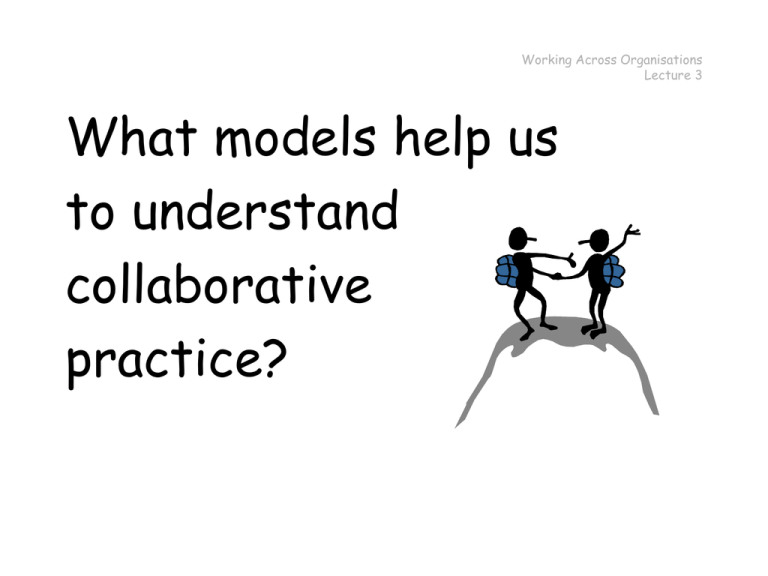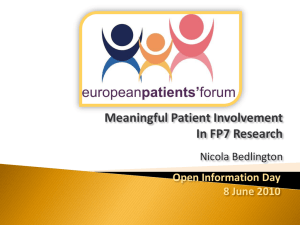Working Across Organisations Lecture 3
advertisement

Working Across Organisations Lecture 3 What models help us to understand collaborative practice? Working Across Organisations Lecture 3 Objectives for this session: • To outline two different theories - systems theory and social exchange theory- to support individuals in analysing and understanding the context of practice; • To reflect on the implications of these theories for personal and professional practice; • To outline a model of collaboration that assists both the practice and analysis of collaborative practice. Working Across Organisations Lecture 3 Systems theory – evolved from mechanical and biological theory. All organisms are systems, composed of subsystems and are in turn part of super systems, e.g. cars and ants! “…something that maintains its existence and functions as a whole through the interaction of its parts” (O’Conner and McDermott, 1997: 24). Working Across Organisations Lecture 3 Concepts about the structures of systems: Systems are entities boundaries within which physical and mental energy are exchanged internally more than they are across boundaries; Closed systems have no interchange cross the boundaries; Open systems occur where energy crosses the boundaries, which are permeable. Working Across Organisations Lecture 3 Input – energy being fed into the system – general and specific elements. Transformation - how the energy is used within the system. Outputs – effect on the environment of energy passed out through the boundaries of a system. Feedback – information and energy passed to the system system across the boundaries. Working Across Organisations Lecture 3 Emphasis is on a social focus rather than on an individual perspective. Think about the social and personal elements in any social situations Elements interact with each other to integrate into a “whole”. Important principles and ideas that can be applied to collaborative practice and to organisations. Working Across Organisations Lecture 3 What is its relevant in systems theory to collaboration? 1. 2. 3. 4. Interaction and interdependence. ‘Energy’ in the form of information. Resources and services. Interdependence of wholes Working Across Organisations Lecture 3 Social Exchange theory –a relationship maintenance theory, which looks at how people arrive at their decisions in relationships. Strong element of reciprocity, a calculation of return; there is some element of self interest in all instances of social exchange and the incurring of obligation or indebtedness. Working Across Organisations Lecture 3 Social Exchange theory explains how we feel about a relationship with another person as depending on our perceptions of: • • • • • • Cost-benefit analysis Power differences The negotiation of expectations Understanding of the roles and responsibilities The kind of relationship we deserve The chances of having a better relationship with someone else Working Across Organisations Lecture 3 • Social exchanges are characterized by inter- dependence; • Social exchanges are regulated by norms; • Trust and commitment result from the emergent experiences; Working Across Organisations Lecture 3 A Model of Collaboration (Whittington, 2003) Five interconnected spheres 1. Service users and carers; 2. Personal; 3. Professional; 4. Team; 5. Organisational . “SUPPORT” Working Across Organisations Lecture 3 Concepts drawn from the theories and the model outlined: • Attitude • Knowledge • Skills Working Across Organisations Lecture 3 “… (collaboration) depends on a sufficient perception of what is necessary, and what is to be gained……the crucial perception for interagency and interprofessional collaboration is the recognition of interdependence …” (Loxley, 1997:41) Working Across Organisations Lecture 3 References Abrams, P and Bulmer, M. (1986) "Neighbours, the work of Philip Abrams", Cambridge: Cambridge University Press Beresford, P. (2002) “Making User Involvement Real” Professional Social Work, June, 16 –17. Department of Health (2001) National Service Framework for Older People, London: Stationery Office. Loxley, A. (1997) Collaboration in Health and Welfare, London: Jessica Kingsley. O’Conner, J. and McDermott, I. (1997) The Art of Systems Thinking London: Thorsen Scott J (1992) "Social Network Analysis", London: Sage Travers, J. and Milgram, S. (1969) An experimental study of the small world problem. Sociometry, 32, 425–443. Whittington, C. (2003) A Model of Collaboration, In Weinstein, J., Whittington, C. and Leiba, T. (eds.) (2003) Collaboration in Social Work Practice, London: Jessica Kingsley.






